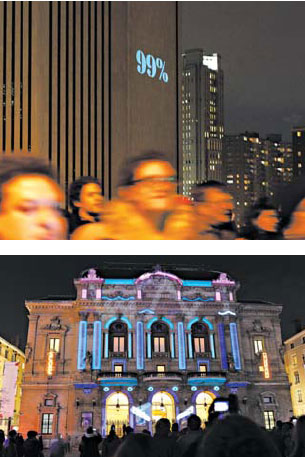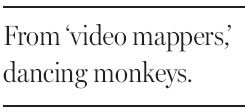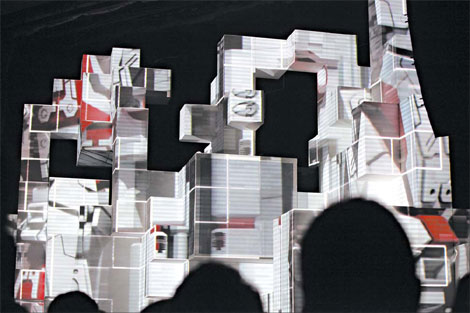Lit-up buildings as canvas for art
Updated: 2012-02-05 08:01
By Adrienne Day (The New York Times)
|
|||||||||||
|
A projection at the Brooklyn Masonic Temple accompanied a performance by the musician Amon Tobin. Below, visual support for Occupy Wall Street protesters. Bottom, the Fete des Lumieres in France has celebrated light as art for 150 years. A light projection in December. Michelle V. Agins / The New York Times; Below, Jessica Rinaldi / Reuters; bottom, Muriel Chaulet |
There is a commercial building at the intersection of Canal Street and West Broadway in downtown Manhattan with a whitewashed and windowless side that most people would consider an eyesore. But for JR Skola on a recent evening it was a six-story canvas for a traveling work called "Space Monkey."
Mr. Skola, a founder of the Dawn of Man art collective, used a laptop, a portable generator and a projector strapped to the roof of his car to cast on the building an enormous video of a dancing monkey (a five-minute loop of a friend in a costume). While the creature flapped its arms and kicked its feet, people stopped on the street to gawk and snap photos.
"When we project this in the Lower East Side," Mr. Skola said, "drunk people try to dance like the monkey."
Mr. Skola and his creative partner Max Nova create guerrilla projections; works that are shown in public without any of the necessary approvals. They are part of a "video mapping" art scene that is bubbling up in New York, London and other urban centers.
While video projection art is not new, it has become much more ambitious thanks to recent advancements in 3-D-projection mapping, a technology that helps create the illusion of multidimensional movement across or around the contours of any surface, regardless of its shape. And cheaper versions of video mapping software are now on the market.

These projections require no special glasses to perceive them in three dimensions; popular online clips, like one of hands playing a building like it's a piano, by Urbanscreen, a company in Germany, demonstrate the seductive power of this medium. "This is a new world where artists can show their work in any location," said Dave Haroldsen, a creative director for a global tech-arts festival called the Creators Project. "It's brilliant and shocking and new, and it really speaks to youth."
One of the most prominent festivals dedicated to the art form is the long-running "Fete des Lumieres" in Lyon, France. The tradition there of placing candles in household windows in honor of the Virgin Mary dates back more than 150 years, and the modern incarnation of the festival began incorporating 3-D-mapping techniques in recent years.
On December 8, the opening day of the festival, the installation "Urban Flipper" turned the facade of an old theater into the world's largest interactive pinball machine. Balls ricocheted around the facade, accompanied by a barrage of video-arcade noises and exhilarating light effects.
Matthew Clark, a founder of the London collective United Visual Artists, said that what excites him the most about video mapping technology is that it enables him to break away from the traditional flat rectangle that most people associate with film.
"It's quite liberating," Mr. Clark said. "Suddenly anything can be your canvas." The 2012 Olympic Delivery Authority has commissioned United Visual Artists to join in designing a "stadium" to be made solely of fabric and light.
Some video mapping art has an activist tinge. In November Mark Read, an artist and activist, organized an Occupy Wall Street projection, nicknamed the "Bat Signal," and recruited Mr. Nova and Mr. Skola for their large-scale projection savvy. Mr. Read said he is now helping to create a sort of "Batmobile" with projection capabilities that will visually spread the word that the Occupy movement is still alive.
Along similar lines, about six years ago the new-media artist Evan Roth helped pioneer the use of a digital laser pen and a video projector to write graffiti in public spaces, much as a traditional graffiti artist would use a spray can. Art collectives in cities like Berlin and Belo Horizonte, Brazil, use Mr. Roth's methods to tag buildings, bridges and schoolyards. But despite the potential subversive thrill, this graffiti lasts only as long as the projector is on, which is why video sites like YouTube are vital in preserving it.
"It's the kind of activism that isn't just making a sign," said Mr. Roth, 33. "And it's something people my age might be interested in taking part of irregardless of the politics."

The tools of 3-D projection mapping have also infiltrated music. Artists like the rapper Drake and the electronic musicians Skrillex and Amon Tobin recently toured the United States with mind-boggling stagecraft that employed video mapping. Many corporate customers are also using elements of 3-D-projection mapping in their marketing campaigns. Some video-mapping artists look askance at such commercialism, but Mr. Nova, who also works on projects for clients like the Museum of Modern Art and Heinz Ketchup, seems comfortable on both sides of the art versus commerce divide.
Back on Canal Street in Manhattan, a car pulled over to take a closer look at the gyrating Space Monkey. The driver rolled down his window. "Hey!" he yelled. "Is this a commercial or is this art?"
The New York Times
Today's Top News
Rescuers race against time for quake victims
Telecom workers restore links
Coal mine blast kills 18 in Jilin
Intl scholarship puts China on the map
More bird flu patients discharged
Gold loses sheen, but still a safe bet
US 'turns blind eye to human rights'
Telecom workers restore links
Hot Topics
Lunar probe , China growth forecasts, Emission rules get tougher, China seen through 'colored lens', International board,
Editor's Picks

|

|

|

|

|

|






